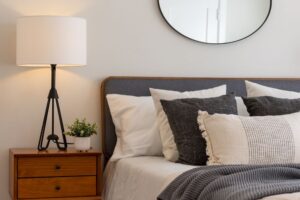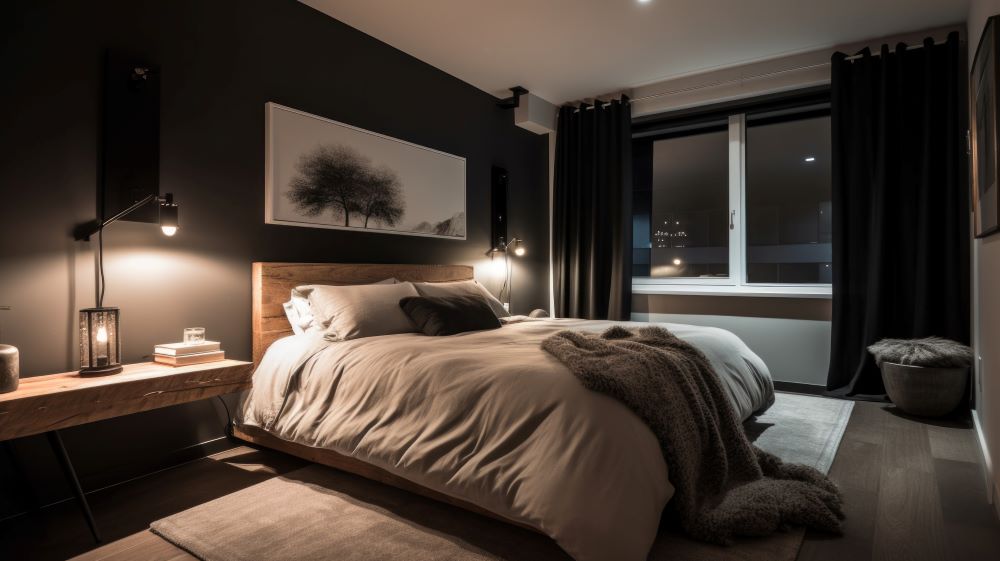Use Lighting to Transform the Look and Feel of Your Bedroom
Lighting plays a crucial role in transforming the look and feel of a bedroom. By understanding the different types of lighting and choosing the right light fixtures, one can create a layered lighting design that enhances both functionality and aesthetics.
This article will explore these various aspects of using lighting to transform the bedroom, providing readers with a comprehensive understanding of how lighting can greatly impact the overall look and feel of their personal space.
Understanding Different Types of Lighting

Different types of lighting can create various effects in a bedroom, and understanding these variations is crucial in achieving the desired ambience.
Lighting options can be broadly categorized into three types: ambient lighting, task lighting, and accent lighting.
Ambient lighting refers to the general illumination of a room and is usually achieved through ceiling-mounted fixtures or wall sconces. It provides overall brightness and sets the mood for the space.
Task lighting focuses on specific activities such as reading or working. Table lamps or adjustable wall-mounted fixtures are commonly used for this purpose.
Accent lighting highlights particular features or objects, such as artwork or architectural elements. Spotlights or track lighting are often employed for accent lighting.
By carefully selecting and combining these different types of lighting, one can create a visually appealing and functional bedroom environment.
Choosing the Right Light Fixtures
Selecting the appropriate light fixtures is crucial in creating the desired ambience and aesthetic appeal within the bedroom space. The right choice of light fixtures can completely transform the look and feel of the room.
To visualise the impact of the right light fixtures, consider the following nested bullet point list:
- Wall Sconces:
- Mounted on the walls, these fixtures provide ambient lighting while adding a touch of elegance to the room.
- They create a soft, diffused glow that helps create a relaxing and cosy atmosphere.
- Pendant Lights:
- Suspended from the ceiling, pendant lights are versatile and can be used as a focal point or for task lighting.
- They come in various styles and designs, allowing for customisation to match the overall bedroom decor.
The bedroom can be transformed into a comfortable and visually appealing space that meets the desired aesthetic by carefully selecting the appropriate fixtures.
Creating a Layered Lighting Design
A layered lighting design is essential for a visually dynamic and atmospheric bedroom.
By incorporating different types of lighting fixtures and placing them strategically throughout the room, a layered lighting design adds depth and dimension to the space.
Ambient lighting is the primary illumination source, providing overall brightness and setting the mood. Task lighting, however, is focused and directed, illuminating specific areas for activities such as reading or getting dressed. Accent lighting highlights architectural features or artwork, adding visual interest and creating a focal point.
By combining these different layers of lighting, a bedroom can be transformed into a versatile and inviting space, allowing for various activities and creating a soothing and relaxing atmosphere.
With careful planning and consideration, a layered lighting design can greatly enhance the look and feel of any bedroom.
Using Task Lighting for Functionality
Implementing task lighting in a bedroom is crucial for enhancing functionality and providing focused illumination for specific activities.
Task lighting refers to lighting fixtures designed to illuminate specific areas where tasks such as reading, studying, or applying makeup are performed. This type of lighting is typically brighter and more focused than ambient or decorative lighting, ensuring that the task at hand is adequately illuminated.
For example, a bedside lamp with an adjustable arm can provide direct light for reading in bed, while a desk lamp with a focused beam can illuminate a workspace for studying or working on a laptop.
By incorporating task lighting into the bedroom design, individuals can improve their productivity, comfort, and overall experience.
Incorporating Ambient Lighting for Relaxation
Integrating ambient lighting in a bedroom design can create a calming atmosphere conducive to relaxation and unwinding.
Ambient lighting refers to the general illumination of a space, providing a soft, diffused light that is not overly bright or harsh. This type of lighting is typically achieved through ceiling fixtures, wall sconces, or table lamps with opaque or translucent shades.
By incorporating ambient lighting in a bedroom, individuals can create a soothing environment that promotes relaxation after a long day. The soft, gentle glow of ambient lighting helps to reduce stress and create a peaceful ambience.
Additionally, it can highlight architectural features or decorative elements in the bedroom, enhancing the overall aesthetic appeal of the space.
Overall, incorporating ambient lighting in a bedroom design can transform the look and feel of the room, promoting a sense of tranquillity and calmness for a restful night’s sleep.
Adding Accent Lighting to Highlight Decorative Elements
Incorporating ambient lighting in the bedroom creates a relaxing atmosphere, but adding accent lighting takes the visual appeal to a whole new level.
Accent lighting refers to using light fixtures to highlight specific decorative elements in a room. You can draw attention to artwork, architectural features, or any other visually appealing objects in your bedroom by strategically placing accent lights. This type of lighting adds depth and dimension to the space, creating a focal point and directing the eye towards the desired area.
Accent lighting can be achieved through various fixtures such as wall sconces, pendant lights, or even table lamps. The intensity and direction of the light can be adjusted to create the desired effect.
You can transform your bedroom into a visually captivating and aesthetically pleasing sanctuary by incorporating accent lighting.
Installing Dimmer Switches for Versatility

Installing dimmer switches in the bedroom allows for versatile control over the intensity of the light, providing the ability to create different moods and atmospheres within the space. This simple addition to the lighting system can significantly impact the room’s overall ambience.
- Enhance relaxation: Dimming the lights can create a soothing and calming environment, perfect for winding down at the end of the day or practising meditation and mindfulness.
- Set the mood: Whether it’s a romantic evening or a cosy night with a good book, dimmer switches allow you to adjust the lighting to create the desired atmosphere easily.
- Improve sleep quality: Dimming the lights before bedtime signals the body that it’s time to rest, helping to promote more restful and rejuvenating sleep.
By installing dimmer switches, you can transform your bedroom into a versatile and comfortable sanctuary tailored to your specific needs and preferences.
Using Color Temperature to Set the Mood
Dimmer switches provide versatility in adjusting the brightness of your bedroom lighting. However, to truly transform the look and feel of the space, it is important to consider the colour temperature of the lighting.
Colour temperature refers to the warmth or coolness of light, measured in Kelvin (K). Different colour temperatures can evoke different moods and create various atmospheres in a room.
For instance, warm light with a lower colour temperature (around 2700K to 3000K) creates a cosy and intimate ambience, perfect for relaxation and winding down. On the other hand, cooler light with a higher colour temperature (around 4000K to 5000K) gives a brighter and more energising feel, ideal for tasks such as reading or working.
By strategically using colour temperature, you can set the mood and create the desired atmosphere in your bedroom.
Positioning Lights for Optimal Effect
Positioning lights strategically in a space can maximise their effects and enhance the overall atmosphere. When it comes to transforming the look and feel of a bedroom, the positioning of lights plays a crucial role.
Here are a few key considerations to keep in mind:
- Ambient Lighting: Placing lights around the room’s perimeter can create a soft, diffused glow that helps establish a relaxing ambience.
- Task Lighting: Positioning lights near specific areas, such as the bedside or a reading nook, allows for focused illumination, making these spaces functional and inviting.
- Accent Lighting: By strategically placing lights to highlight artwork, architectural features, or decorative elements, you can add depth and visual interest to the overall bedroom design.
By carefully considering the positioning of lights in your bedroom, you can create a space that meets your functional needs and evokes a desired emotional response, whether it be calmness, cosiness, or sophistication.
Incorporating Natural Light Sources
Incorporating natural light sources into a bedroom design can enhance the overall aesthetic and create a captivating interplay between light and space. It is essential to consider the placement and size of windows to maximise the entry of natural light.
Large windows or floor-to-ceiling glass doors can serve as focal points, allowing ample natural light to flood the room and create a sense of openness. Light-coloured curtains or blinds can help diffuse the natural light, creating a soft and inviting atmosphere.
Another effective way to incorporate natural light is by using mirrors strategically. Placing mirrors opposite windows can reflect and amplify the natural light, making the room feel brighter and more spacious.
Furthermore, incorporating light-coloured furniture and décor can help bounce natural light throughout the space, enhancing the overall visual appeal of the bedroom.
Using Lighting to Define Zones in the Bedroom
By strategically dividing the bedroom into distinct zones with the use of lighting, it creates a visually appealing and functional space for various activities.
Lighting can be used to define different areas within the bedroom, such as the sleeping area, reading nook, or dressing area. For instance, task lighting can be employed near the bedside to provide adequate illumination for reading or other activities, while ambient lighting can create a soothing and relaxing atmosphere for sleep. Additionally, accent lighting can highlight certain features or decorative elements, adding visual interest to the space.
Careful consideration should be given to the placement and intensity of the lights to ensure that each zone is well-defined and serves its intended purpose. Overall, lighting to define the bedroom’s zones enhances the space’s functionality and aesthetics.
Incorporating Smart Lighting Systems
A smart lighting system in the bedroom can enhance convenience and efficiency by allowing users to control the lighting remotely or through voice commands. These systems utilise advanced technology such as motion sensors, timers, and dimmable bulbs to create a personalised lighting experience.
With the ability to adjust the brightness and colour temperature of the lights, users can easily create different moods and ambiences in their bedrooms. Smart lighting systems can also be integrated with other smart home devices, such as smart speakers or virtual assistants, creating a seamless and interconnected ecosystem.
This enables users to automate their lighting schedule, set up wake-up routines, or even sync the lights with music or movies. Overall, incorporating smart lighting systems in the bedroom provides users with a convenient and customisable lighting solution that can transform the look and feel of their space.
Adding Decorative Lighting Fixtures
Adding decorative lighting fixtures can add a touch of elegance and sophistication to the bedroom ambience, creating a visually stunning and inviting space.
These fixtures come in a variety of styles, such as chandeliers, pendant lights, wall sconces, and table lamps, allowing for customisation to suit individual preferences. With their intricate designs and crystal accents, Chandeliers can serve as a focal point and enhance the room’s overall aesthetics.
Pendant lights can be strategically placed to provide task lighting or highlight specific areas, such as a reading nook or vanity.
Wall sconces can add a warm and intimate glow, while table lamps offer versatility and functionality.
Additionally, decorative lighting fixtures can be used to complement existing decor or serve as statement pieces, further elevating the overall look and feel of the bedroom.
Considering Energy Efficiency and Sustainability

Moving on from adding decorative lighting fixtures, it is important to consider the aspect of energy efficiency and sustainability when transforming the look and feel of your bedroom through lighting. Energy efficiency plays a vital role in reducing electricity consumption and minimising environmental impact.
Opting for energy-efficient lighting options, such as LED bulbs, can significantly reduce energy usage while providing ample illumination. Sustainable lighting solutions, such as solar-powered or motion-sensor lights, offer a greener alternative. These options not only conserve energy but also contribute to long-term cost savings.
Considering the lifespan of the lighting fixtures and their environmental impact is also crucial. By selecting eco-friendly materials and responsibly disposing of old fixtures, you can further enhance the sustainability of your bedroom lighting.
Experimenting with Lighting Arrangements and Styles
Exploring various lighting arrangements and styles can enhance bedroom space’s aesthetic appeal and ambience.
- Task lighting: This type of lighting is focused on a specific area or task, such as reading or getting ready in the morning. It can be achieved through bedside table lamps, wall-mounted sconces, or pendant lights above a vanity.
- Ambient lighting: This lighting creates a soft, overall glow in the room. It can be achieved through recessed ceiling lights, chandeliers, or wall-mounted fixtures that provide indirect lighting.
- Accent lighting: This type of lighting highlights a specific feature or object in the bedroom, such as artwork or architectural details. It can be achieved through adjustable track lighting, picture lights, or wall-mounted spotlights.
By combining different lighting arrangements and styles, individuals can create a personalised and visually appealing bedroom environment that suits their needs and preferences.
Conclusion
In conclusion, lighting plays a crucial role in transforming the look and feel of your bedroom. By understanding different types of lighting and choosing the right light fixtures, you can create a layered lighting design that combines functionality and relaxation.
Incorporating task lighting for specific tasks and ambient lighting for a soothing atmosphere can greatly enhance your bedroom’s ambience. Additionally, smart lighting systems offer convenience and control. Decorative lighting fixtures add aesthetic appeal while considering energy efficiency and sustainability as important for long-term benefits.
Experimenting with lighting arrangements and styles lets you personalise your bedroom’s lighting to suit your preferences and needs.


